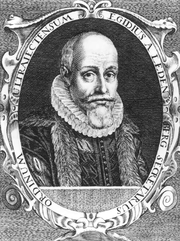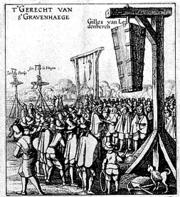
Gilles van Ledenberg
Encyclopedia

Utrecht (province)
Utrecht is the smallest province of the Netherlands in terms of area, and is located in the centre of the country. It is bordered by the Eemmeer in the north, Gelderland in the east, the river Rhine in the south, South Holland in the west, and North Holland in the northwest...
from 1588 until his arrest for treason in 1618, together with Johan van Oldenbarnevelt. He committed suicide
Suicide
Suicide is the act of intentionally causing one's own death. Suicide is often committed out of despair or attributed to some underlying mental disorder, such as depression, bipolar disorder, schizophrenia, alcoholism, or drug abuse...
to prevent forfeiture of his assets, but he was sentenced to death posthumously and posthumously executed.
Career
Ledenberg had humble origins. His father was probably a masonMasonry
Masonry is the building of structures from individual units laid in and bound together by mortar; the term masonry can also refer to the units themselves. The common materials of masonry construction are brick, stone, marble, granite, travertine, limestone; concrete block, glass block, stucco, and...
. He may have been a friar
Friar
A friar is a member of one of the mendicant orders.-Friars and monks:...
in his youth. However, he worked himself up to clerk of Floris Thin, the pensionary of the States of Utrecht, whom he succeeded in 1590, due to an intrigue by Oldenbarnevelt who wished to block the appointment of his rival Paulus Buys
Paulus Buys
Paulus Buys, heer van Zevenhoven and Capelle ter Vliet was Grand Pensionary of Holland between 1572 to 1584.-Life:...
in that position. He had been secretary of the States from 1588 and also was appointed Clerk of the Utrecht "Leenhof" (one of the courts). He was married several times, lastly to Johanna van Sypesteyn (member of an aristocratic family).
Arrest and trial
Ledenberg's notoriety derives from his role in the waardgelder crisis of 1618. During the Twelve Years' TruceTwelve Years' Truce
The Twelve Years' Truce was the name given to the cessation of hostilities between the Habsburg rulers of Spain and the Southern Netherlands and the Dutch Republic as agreed in Antwerp on 9 April 1609. It was a watershed in the Eighty Years' War, marking the point from which the independence of the...
social unrest had arisen because of the conflict in the Dutch Reformed Church
Dutch Reformed Church
The Dutch Reformed Church was a Reformed Christian denomination in the Netherlands. It existed from the 1570s to 2004, the year it merged with the Reformed Churches in the Netherlands and the Evangelical Lutheran Church in the Kingdom of the Netherlands to form the Protestant Church in the...
between the Remonstrants
Remonstrants
The Remonstrants are the Dutch Protestants who, after the death of Jacobus Arminius, maintained the views associated with his name. In 1610 they presented to the States of Holland and Friesland a remonstrance in five articles formulating their points of disagreement from Calvinism.-History:The five...
and their opponents. Mobs had attacked regents
Regenten
In the 16th, 17th and 18th centuries, the regenten were the rulers of the Dutch Republic, the leaders of the Dutch cities or the heads of organisations . Though not formally a hereditary "class", they were de facto "patricians", comparable to that ancient Roman class...
of the Remonstrant party while the civic militias and the federal military authorities looked the other way. To protect themselves, these regents had pushed through the so-called Sharp Resolution in the States of Holland which allowed the local authorities in cities to recruit their own companies of mercenaries, called waardgelders, to maintain order. This was seen as a threat to his authority as commander-in-chief of the federal forces of the Dutch Republic
Dutch Republic
The Dutch Republic — officially known as the Republic of the Seven United Netherlands , the Republic of the United Netherlands, or the Republic of the Seven United Provinces — was a republic in Europe existing from 1581 to 1795, preceding the Batavian Republic and ultimately...
by stadtholder
Stadtholder
A Stadtholder A Stadtholder A Stadtholder (Dutch: stadhouder [], "steward" or "lieutenant", literally place holder, holding someones place, possibly a calque of German Statthalter, French lieutenant, or Middle Latin locum tenens...
Maurice of Nassau, Prince of Orange
Maurice of Nassau, Prince of Orange
Maurice of Nassau, Prince of Orange was sovereign Prince of Orange from 1618, on the death of his eldest half brother, Philip William, Prince of Orange,...
. Maurice now canvassed the States of the several provinces about the possible suppression of the waardgelders. On his way to Gelderland
Gelderland
Gelderland is the largest province of the Netherlands, located in the central eastern part of the country. The capital city is Arnhem. The two other major cities, Nijmegen and Apeldoorn have more inhabitants. Other major regional centers in Gelderland are Ede, Doetinchem, Zutphen, Tiel, Wijchen,...
he was initially refused entry to the city of Utrecht and when he finally was allowed to stay there overnight, Ledenberg had his hotel guarded by civic militia, which was interpreted as an attempt at intimidation.
Because the city of Utrecht
Utrecht (city)
Utrecht city and municipality is the capital and most populous city of the Dutch province of Utrecht. It is located in the eastern corner of the Randstad conurbation, and is the fourth largest city of the Netherlands with a population of 312,634 on 1 Jan 2011.Utrecht's ancient city centre features...
appeared first in line to have its waardgelders disarmed, the States of Utrecht sent a delegation to The Hague to discuss the matter with Maurice, of which Ledenberg was a prominent member. Instead of seeking out Maurice, however, this delegation engaged in conversations with prominent members of the Remonstrant party in Holland, like Hugo Grotius
Hugo Grotius
Hugo Grotius , also known as Huig de Groot, Hugo Grocio or Hugo de Groot, was a jurist in the Dutch Republic. With Francisco de Vitoria and Alberico Gentili he laid the foundations for international law, based on natural law...
, Rombout Hogerbeets
Rombout Hogerbeets
Rombout Hogerbeets was a Dutch jurist and statesman. He was tried for treason, together with Johan van Oldenbarnevelt, Hugo Grotius, and Gilles van Ledenberg during the political crisis of 1617-1618 in the Dutch Republic, and sentenced to life-imprisonment...
and the pensionary of Haarlem
Haarlem
Haarlem is a municipality and a city in the Netherlands. It is the capital of the province of North Holland, the northern half of Holland, which at one time was the most powerful of the seven provinces of the Dutch Republic...
, De Haan. They discussed several objections against the proposed suppression of the waardgelders with members of the States of Holland in an informal meeting at the house of the clerk of the States, which led to agreement to oppose the suppression. The Utrecht delegation then returned home without having seen Maurice. Next, Ledenberg convinced the States of Utrecht to adopt this policy and he also tried to thwart the march of federal troops to Utrecht after the disbanding of the waardgelders had been authorizedby the States-General
States-General of the Netherlands
The States-General of the Netherlands is the bicameral legislature of the Netherlands, consisting of the Senate and the House of Representatives. The parliament meets in at the Binnenhof in The Hague. The archaic Dutch word "staten" originally related to the feudal classes in which medieval...
. These activities clearly marked him as an opponent of Maurice.
After Maurice had taken over Utrecht and disbanded the waardgelders there at the end of July, 1618, Ledenberg resigned his offices and fled to Gouda
Gouda
Gouda is a city and municipality in the western Netherlands, in the province of South Holland. Gouda, which was granted city rights in 1272, is famous for its Gouda cheese, smoking pipes, and 15th-century city hall....
. When he returned to Utrecht he was placed under house arrest and finally arrested together with Oldenbarnevelt, Grotius, Hogerbeets and De Haan on August 29, 1618. He was locked up in the Binnenhof
Binnenhof
The Binnenhof , is a complex of buildings in The Hague. It has been the location of meetings of the Staten-Generaal, the Dutch parliament, since 1446, and has been the centre of Dutch politics for many centuries....
, but allowed the company of his son. The preliminary investigation in his trial was conducted by the fiscal (prosecutor) Van Leeuwen, who was a personal enemy (Ledenberg had engineered his dismissal a few years earlier). Van Leeuwen apparently threatened him with the rack and this may have driven Ledenberg to despair. He committed suicide by cutting his throat in the night of 28/29 September. He had left a suicide note in French with his son which indicated that he hoped to prevent forfeiture
Asset forfeiture
Asset forfeiture is confiscation, by the State, of assets which are either the alleged proceeds of crime or the alleged instrumentalities of crime, and more recently, alleged terrorism. Instrumentalities of crime are property that was allegedly used to facilitate crime, for example cars...
of his possessions in this way, because he expected his trial to end with his death.

Posthumous execution
Posthumous execution is the ritual or ceremonial mutilation of an already dead body as a punishment.-Examples:* Li Linfu, Chancellor of Tang China during the reign of Emperor Xuanzong in the latter years, was exhumed and executed for crimes of high treason by his rival Yang Guozhong for his...
by hanging his embalmed body, in its coffin, from a gibbet
Gibbet
A gibbet is a gallows-type structure from which the dead bodies of executed criminals were hung on public display to deter other existing or potential criminals. In earlier times, up to the late 17th century, live gibbeting also took place, in which the criminal was placed alive in a metal cage...
. It was left hanging for 21 days, and after it was taken down, it was buried in the churchyard of the church at Voorburg
Voorburg
Voorburg is a Dutch town and former municipality in the western part of the province of South Holland, the Netherlands. As also Leidschendam and Stompwijk, it is part of the municipality Leidschendam-Voorburg. It has approximately 39,000 inhabitants....
. However, the same night a mob disinterred the corpse and threw it in a ditch. This caused sufficient revulsion to cause the Hof van Holland (the main Dutch court) to issue an injunction against further depredations. The body was later secretly reburied in a chapel belonging to his son-in-law, Adam van Lokhorst.

